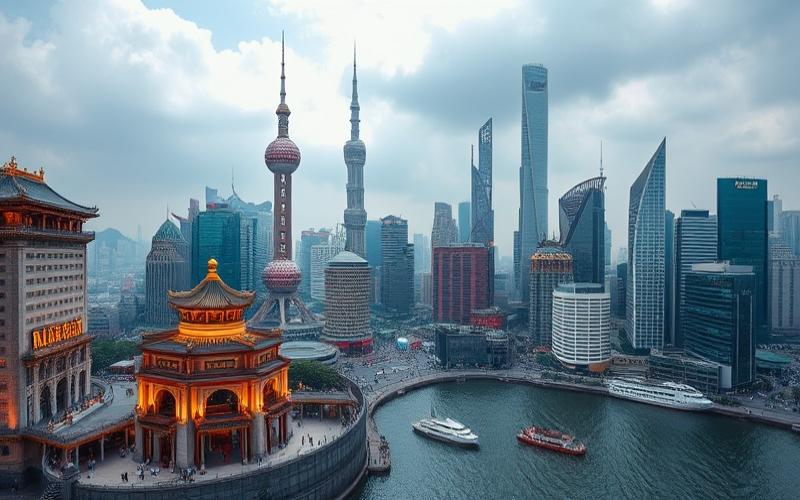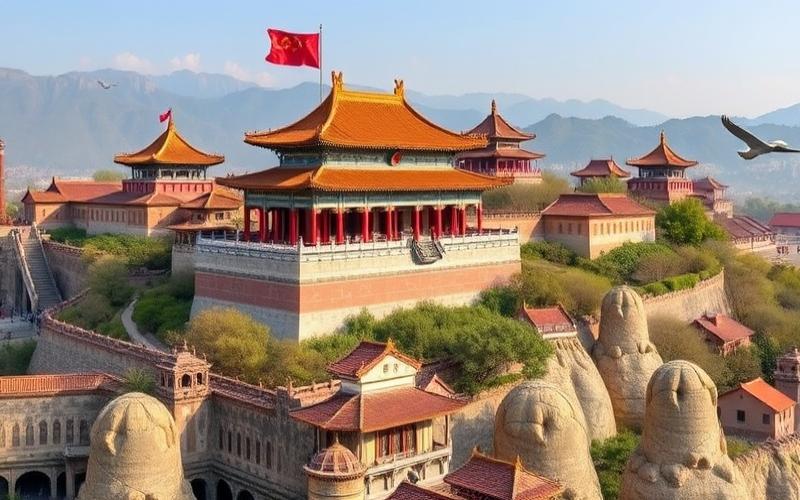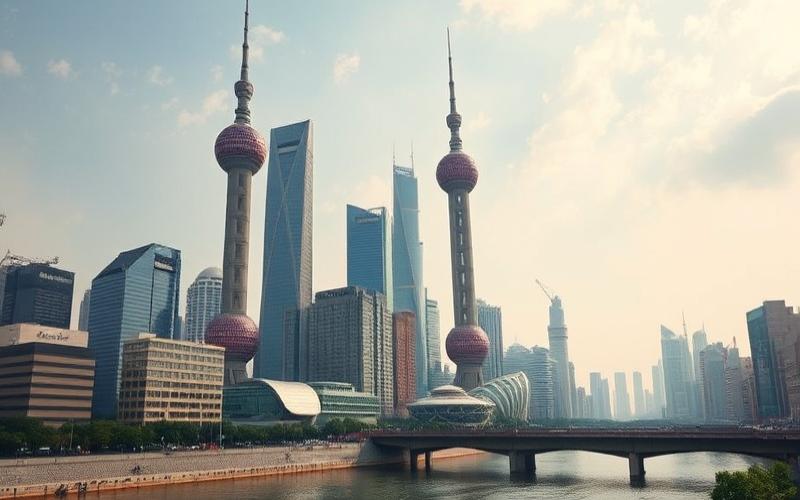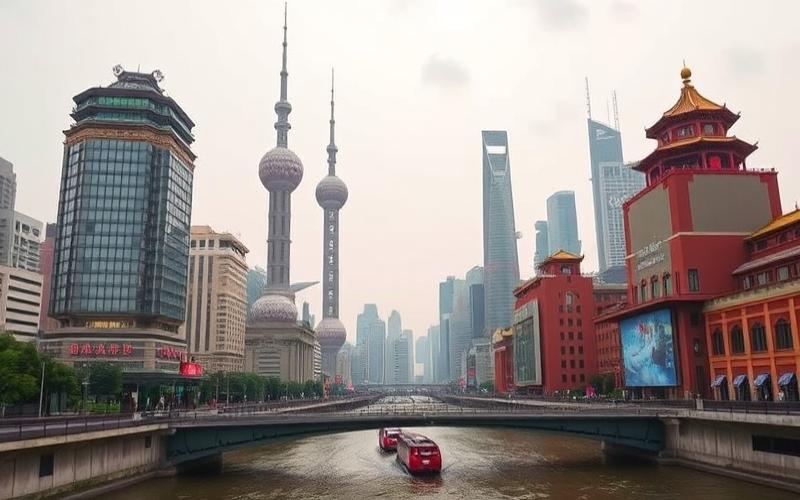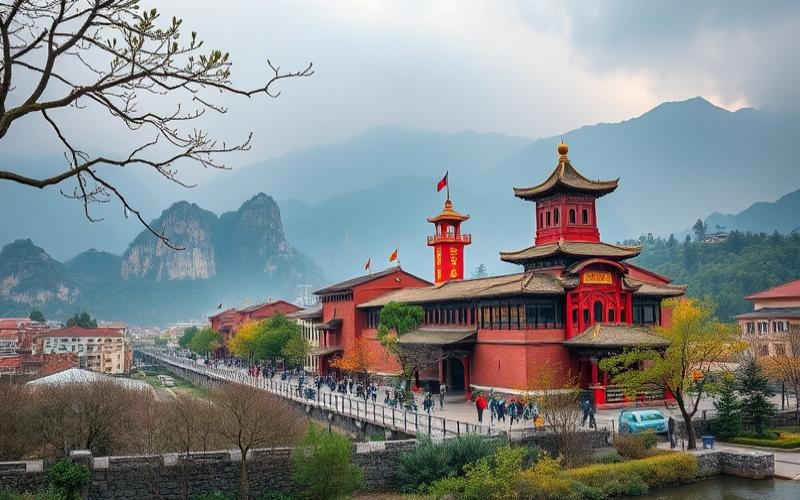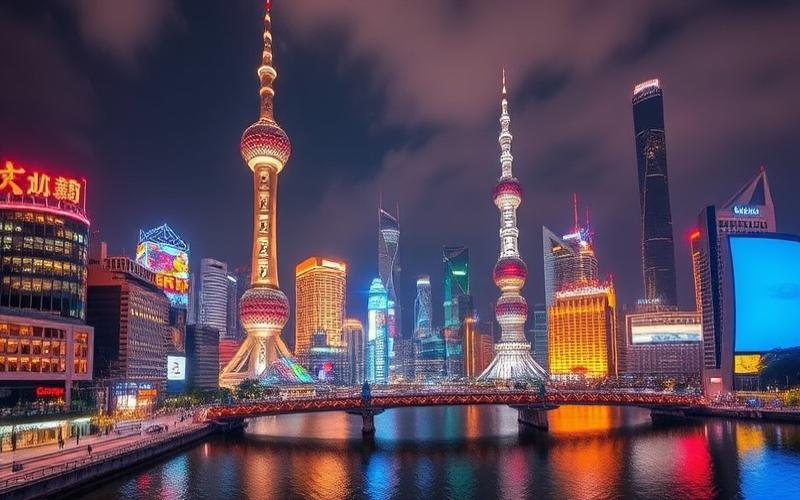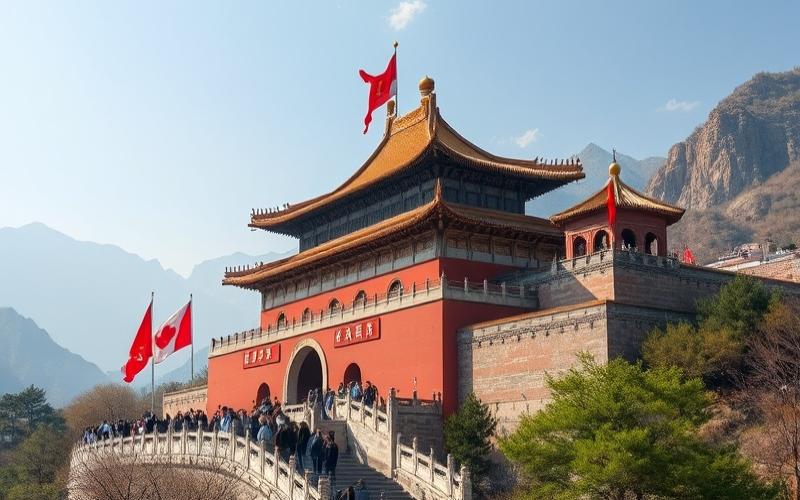
 Published on and written by Cyril Jarnias
Published on and written by Cyril Jarnias
China, a country with unparalleled cultural and spiritual heritage, is home to a mosaic of religious traditions manifested through numerous ancient and modern places of worship. From gleaming Buddhist temples perched on sacred mountains to enchanting mosques nestled in historic cities, and intriguing Christian churches, these sanctuaries embody the convergence of diverse and ancient beliefs.
Each of these religious communities, whether Buddhism, Taoism, Islam, Christianity, or Chinese folk religions, plays a vital role in the country’s social fabric, offering their followers a space for reflection and profound spiritual practices.
This article explores the diversity and interaction of these plural beliefs, which reflect the complexity and religious diversity of a country living in the shadow of growing modernity.
Religious Life in China: A Spiritual Mosaic
China stands out for its remarkable religious diversity, where millennia-old traditions and spiritual currents from elsewhere coexist. This pluralism is evident in the country’s daily life, ritual practices, and urban landscapes.
Major Religions and Beliefs in China
| Religion/Belief | Origin and Development | Practices and Current Presence | Iconic Places of Worship | Influential Communities |
|---|---|---|---|---|
| Buddhism | Introduced in the 1st century, peaked under the Tang | Monasteries, rituals, festivals | White Horse Temple (Luoyang), Shaolin | Monks, laity, Chan schools |
| Taoism | Originated in China in the 4th century BCE | Temples, alchemy, immortal cults | Mount Wudang, Nuwa Temple (Shanxi) | Priests, monastic orders |
| Confucianism | 5th century BCE, founded by Confucius | Rites, ancestor worship, morality | Temple of Confucius (Qufu) | Scholars, traditional elites |
| Islam | Arrived in the 7th century | Mosques, festivals, halal | Huaisheng Mosque (Guangzhou), Id Kah (Kashgar) | Hui, Uyghurs, Kazakhs |
| Christianity | Introduced as early as the 7th century (Nestorianism), modern growth in the 19th century | Churches, liturgy, social works | Immaculate Conception Cathedral (Beijing) | Protestants, Catholics |
| Folk Beliefs | Indigenous foundations | Ancestor worship, local gods, fengshui | Earth Temples, family altars | Village communities |
| Minority Religions | Shamanism, animism (ethnic minorities) | Ethnic rituals, local festivals | Shamanic altars, natural sacred sites | Daur, Evenki, Derung, etc. |
Historical Evolution of Religious Practices
- Antiquity: Predominance of ancestor worship, spirits, and natural forces.
- Birth of Major Currents: Taoism structured from indigenous beliefs, then Buddhism arrived from India and established itself permanently. Confucianism became an ethical and political foundation, though sometimes viewed as a philosophy rather than a religion.
- Syncretism: The three teachings (Buddhism, Taoism, Confucianism) blended, often in the same temples or rituals.
- Arrival of Islam and Christianity: Via the Silk Road, then Western missions.
- 20th Century: Periods of repression, notably during the Cultural Revolution (1966-1976). Since the 1980s, resurgence of religious practices, but under state control.
Impact on Chinese Culture and Society
- Confucian principles still govern family and social relationships.
- Festivals (Chinese New Year, Qingming, Ghost Festival) are marked by religious or folk rituals.
- Architecture (pagodas, temples, altars) and Chinese art bear the imprint of this spiritual diversity.
- Values of ancestor respect, hierarchy, and harmony are inherited from this religious melting pot.
Interactions and Coexistence
- Boundaries between religions are often permeable: an individual may pray at a Taoist temple, participate in a Buddhist festival, and practice Confucian rites.
- Syncretism: Blending of practices and beliefs, local adaptation of major religions.
- Ethnic Communities: Uyghurs (Muslims), Tibetans (Lamaist Buddhists), Hui (Sinicized Muslims) embody regional and religious diversity.
Contemporary Challenges
- Official Recognition: Only five religions (Buddhism, Taoism, Islam, Catholicism, Protestantism) are recognized by the state.
- State Control: Surveillance of places of worship, appointment of religious leaders, censorship of unrecognized movements (e.g., Falun Gong).
- Persecution and Discrimination: Restrictions on certain minorities (e.g., Uyghurs in Xinjiang), closures of unregistered temples or churches.
- Secularization: Urbanization and modernization sometimes lead to a decline in traditional practices, but also their adaptation to modern life.
Role of the State and Religious Policies
- Centralized Management: Official religious associations under government supervision.
- Promotion of Religious Patriotism: Religious communities must emphasize social harmony and national unity.
- Sinicization Policy: Adaptation of religions to Chinese values and culture, limitation of foreign influences.
Examples of Iconic Places of Worship and Communities
- Temple of Heaven (Beijing): Imperial ceremonies for the country’s prosperity.
- Shaolin Monastery: Epicenter of Chan Buddhism and martial arts.
- Id Kah Mosque (Kashgar): Largest mosque in China, spiritual heart of the Uyghurs.
- Temple of Confucius (Qufu): Center of Confucian worship.
- Underground Churches: Testament to the vitality of unofficial Christianity.
List of Contemporary Religious Dynamics
- Confessional plurality in major cities.
- Revival of folk cults in rural areas.
- Tensions in regions with strong ethnic minorities.
- Growth of urban Protestant Christianity.
- Maintenance of ritual traditions during major national festivals.
Thus, religious life in China remains a dynamic mosaic, shaped by history, policies, and the creativity of local communities, where ancient legacies and present-day challenges intertwine.
Good to Know:
China is home to notable religious diversity where Buddhism, Taoism, and Confucianism coexist with Islam and Christianity, as well as local folk beliefs. Historically, these religions have permeated Chinese culture and society, influencing every aspect of life from philosophy to art. Interactions between these faiths and their coexistence have shaped complex dynamics, sometimes marked by tensions due to restrictive state policies. Beijing strictly regulates religious activities, posing challenges for local communities. Buddhist temples like the famous Lama Temple in Beijing and the Great Mosque of Xi’an illustrate this spiritual mosaic. Urban Christian communities are experiencing significant growth, while Taoist practices persist in rural areas. Thus, religions in China not only reflect the country’s cultural richness but also highlight contemporary issues of religious freedom.
Iconic Places of Worship for Expatriates
Major iconic places of worship in China welcome expatriates of all faiths and play a crucial role in their integration while preserving the connection with their original religious practices.
Christian Sites
Major cities like Beijing, Shanghai, and Hong Kong have International Churches open to foreigners. These churches often offer services in multiple languages (English, French, Korean, etc.), facilitating participation for non-Mandarin speaking expatriates.
In Beijing, BICF provides services translated simultaneously into different languages.
Many international churches meet after official Chinese services or use conference rooms adapted for a foreign audience. Passport checks at the entrance are common to ensure a truly international community.
These places frequently organize:
- Multilingual Bible study groups
- Cultural events around Christian holidays (Christmas, Easter)
- Integration workshops for newcomers
| City | Location | Languages Offered | Special Activities |
|---|---|---|---|
| Beijing | BICF Fellowship | English/French | Multicultural workshops |
| Shanghai | International Church | English | Intercultural celebrations |
Muslim Mosques
Shanghai stands out for its religious diversity and has several historic mosques that welcome both locals and expatriates:
- Shanghai Xiaotaiyuan Mosque, one of the oldest
- Shanghai Huxi Mosque, very popular
- Pudong Mosque, modern and spacious
- Songjiang Mosque, famous for its unique architecture
These mosques sometimes offer:
- English welcome on Fridays or during Ramadan
- Guided tours to better understand local Muslim history
- Halal markets adapted to specific dietary needs
Buddhist and Taoist Temples
In metropolises such as Shanghai or Guangzhou:
Major temples like the Jade Buddha Temple in Shanghai or the Lama Temple in Beijing are open to international visitors.
Some monks speak English or offer meditation sessions accessible to non-Chinese.
Regular organization of:
- Zen meditation initiations in English
- Traditional festivals shared with expatriate communities
Cultural and Historical Importance
- Most are listed as local heritage for several centuries;
- They serve as both spiritual and social centers;
- They promote cultural exchange between expatriates and locals through their open activities;
- Their architecture reflects the religious blending unique to each city.
These places actively facilitate the maintenance of religious practices for expatriates: They offer an inclusive environment where everyone can practice their faith according to their traditions while benefiting from adapted linguistic support; thus creating an essential bridge between personal spiritual life and social adaptation far from home.
Good to Know:
In China, several iconic places of worship welcome expatriates, offering multilingual services to facilitate their integration. The Sacred Heart Cathedral in Guangzhou, known for its English masses, is a focal point for expatriate Catholic communities. In Beijing, the Niujie Mosque, the city’s oldest, organizes events in Arabic and English, providing a meeting space for expatriate Muslims. For Buddhists, the Jade Buddha Temple in Shanghai is not only a famous tourist site but also a spiritual place offering retreats and meditation classes. Each of these places plays a crucial role in maintaining expatriates’ faith while offering a multicultural meeting platform, thus strengthening the connection with their religious roots while building bridges with local culture.
Religious Communities and Their Social Role
Major Religions Practiced in China
| Religion | Estimated Followers | Particularities |
|---|---|---|
| Buddhism | ~100 million | Predominance of Mahayana tradition, presence of Tibetan Buddhism, importance of temples and monasteries |
| Taoism | Unofficial data | Indigenous religion, ancestor worship, major influence on culture and traditional medicine |
| Confucianism | Not quantified | More a moral philosophy than religion, permeates education, family rites, and public life |
| Islam | 20 to 28 million | Mostly Sunni, Hui and Uyghurs as main groups, strong community identity in some provinces |
| Christianity | 9 to 10 million | Divided into Protestantism (~5M) and Catholicism (~4M), rapid growth of Protestantism, engagement in education and charity |
Participation in Social and Cultural Life
- Buddhism: Management of temples serving as community centers, organization of festivals like Vesak, food donation campaigns, support for natural disaster victims, educational projects in monasteries.
- Taoism: Preservation of natural sites, ceremonies for local peace and prosperity, involvement in traditional medicine, rituals during major festivals (Chinese New Year, Lantern Festival).
- Confucianism: Influence on education, family rites, social conflict resolution, promotion of filial piety and social harmony through cultural associations.
- Islam: Construction and maintenance of mosques, management of community schools, organization of zakat (alms) and food aid, festivals like Eid bringing the community together, initiatives for interfaith dialogue.
- Christianity: Involvement in hospitals, orphanages, distribution of humanitarian goods, creation of support groups for vulnerable populations, literacy and social aid programs.
Examples of Community Initiatives
- Buddhism: Distribution of free meals in monasteries during festivals, welcoming isolated elderly, reforestation of rural areas.
- Islam: Mutual aid programs for needy families during Ramadan, support for internal refugees in Xinjiang.
- Christianity: Building schools in rural areas, vaccination campaigns, creation of mobile clinics.
Historical Evolution and Social Dynamics
Under the empire, traditional religions were integrated into the state apparatus. Confucianism dominated administration, while Buddhism and Taoism played complementary roles.
Under the People’s Republic, periods of repression (notably the Cultural Revolution) reduced the public influence of religions.
Since the 1980s, gradual reopening of places of worship, increase in religious practice, but under close state control.
Economic changes (urbanization, social mobility) have favored the multiplication of religious charitable works, creation of solidarity networks, and emergence of new religious movements.
Relations with Local Authorities
The five recognized religions are supervised by national associations affiliated with the state.
Religious leaders can be elected to public offices (e.g., deputies to the People’s Congress).
Charitable initiatives often need validation by authorities, and promotion of religious “Sinicization” is required.
Relations vary by province: sometimes cooperation for social management, sometimes tensions during control or repression campaigns.
Current Social and Cultural Challenges
- Increased control over religious practices and places of worship.
- Limitation of independent charitable activities from official structures.
- Pressures for “Sinicization” of doctrines and rituals.
- Integration difficulties for some communities, notably Uyghur Muslims and certain unregistered Christian churches.
- Tensions between modernization, preservation of traditions, and local identity affirmation.
Visual Summary of Religious Contribution to Social Cohesion:
| Religious Community | Contribution to Social Cohesion | Current Challenges |
|---|---|---|
| Buddhists | Food aid, environmental protection | Increased surveillance |
| Taoists | Community rites, traditional medicine | Pressure for conformity |
| Confucianists | Social mediation, moral education | Philosophical marginalization |
| Muslims | Ethnic solidarity, charity, education | Discrimination, repression |
| Christians | Aid to the needy, education, health | Restrictions, surveillance |
⎈ Religions in China remain major vectors of mutual aid, education, and cohesion, but evolve under tight political regulation and in a context of profound social changes. ⎈
Good to Know:
In China, religious communities such as Buddhism, Taoism, Confucianism, Islam, and Christianity play a significant role in social life, often organizing solidarity initiatives like food and clothing distribution for the needy or educational programs. The Shaolin Temple, for example, is not only a spiritual place but also a center for cultural and social activities. Historically, these communities have woven a support network within cities and villages, evolving with economic and political reforms since the post-Mao period, thus strengthening social cohesion in a context of rapid modernization. Relations with local authorities vary, with some communities enjoying great freedom of action, while others must navigate cautiously between restrictions and zones of tolerance. Modern challenges include managing increased cultural and religious diversity, adapting to new government policies, and preserving their religious heritage within often restrictive frameworks.
Tips for Practicing Expatriates
For practicing expatriates in China, it is essential to properly prepare for religious and community integration. Here are practical tips to facilitate the search for religious groups and overcome main challenges:
Finding Religious Groups or Expatriate Communities:
- Use online platforms like WeChat, Meetup, or Facebook to find local groups sharing the same faith.
- Approach international denominational associations often present in major cities (e.g., Catholic Relief Services or China Partner).
- Contact established Francophone communities, such as the Francophone Catholic community in Shanghai.
Identifying and Connecting with Local Places of Worship:
- Locate official churches recognized by the government (e.g., Protestant or Catholic Patriotic Church) that generally accept foreigners.
- Seek advice from other expatriates via specialized forums and social networks to avoid risks associated with unofficial gatherings.
- Always verify that the place complies with local regulations to prevent legal complications.
Potential Challenges Faced by Practicing Expatriates:
| Challenge | Proposed Solution |
|---|---|
| Language Barriers | Learn key phrases in Mandarin; seek help from bilingual members; prioritize international communities where English or French is spoken. |
| Cultural Differences | Observe discreetly before active participation; ask experienced members about local etiquette. |
| Legal Restrictions | Get precise information on what is permitted (proselytism prohibited); opt for discreet practice respectful of local legal framework. |
Additional Tips to Facilitate Religious Integration:
- Strictly respect local laws regarding religious practice: avoid public proselytism, comply with schedules and modalities imposed by each official venue.
- Adopt an open attitude towards cultural diversity within local communities: some customs may differ significantly from those in your home country.
Anecdotes & Personal Experiences Reported by Expatriates:
“Upon arriving in Shanghai, I struggled to find a welcoming parish until a colleague added me to the WeChat group ‘Francophone Catholics.’ There, I received all useful information about weekly masses organized in a discreet hotel.”
“When a Chinese friend invited me to his house church, I preferred to decline after reading that these private meetings could be monitored or even banned depending on the region.”
Useful Platforms:
- WeChat groups dedicated to specific religions
- International denominational associations based locally
- Expatriate forums like InterNations
- Private Facebook pages for residents
Adapting requires patience, discernment, and strict respect for the Chinese legal context, but thanks to virtual or physical community support and good intercultural preparation, practicing one’s faith remains possible for many motivated expatriates.
Good to Know:
Practicing expatriates in China may encounter challenges like language and cultural barriers when searching for religious groups or communities sharing the same faith. To overcome these obstacles, it is helpful to learn some basic Mandarin and inform oneself about local customs to facilitate integration. To identify places of worship, online research via platforms like Meetup or InterNations can be effective for finding active religious communities. It is also important to learn about local laws regarding religious practice to avoid misunderstandings. Additionally, joining international associations or expatriate circles sharing the same faith can enrich the experience and provide moral support. For example, a British expatriate found an English-speaking Christian community by browsing WeChat forums, illustrating the value of using digital tools to build bridges.
Disclaimer: The information provided on this website is for informational purposes only and does not constitute financial, legal, or professional advice. We encourage you to consult qualified experts before making any investment, real estate, or expatriation decisions. Although we strive to maintain up-to-date and accurate information, we do not guarantee the completeness, accuracy, or timeliness of the proposed content. As investment and expatriation involve risks, we disclaim any liability for potential losses or damages arising from the use of this site. Your use of this site confirms your acceptance of these terms and your understanding of the associated risks.

